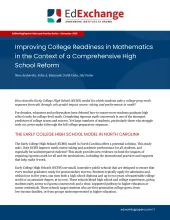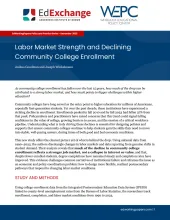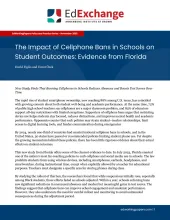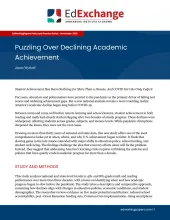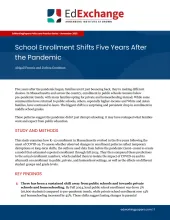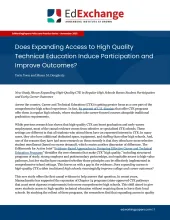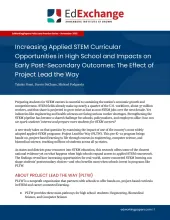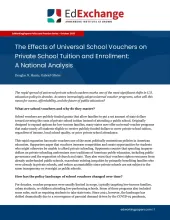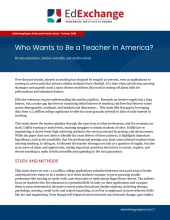EdWorkingPapers Policy and Practice Series
Accelerating Opportunity: The Effects of Instructionally Supported Detracking
For decades, educators and policymakers have debated when students should take Algebra I. Timing matters: taking Algebra earlier, typically in 8th grade, opens the door to advanced math courses in high school, while taking it later can limit college and career opportunities. Yet access to early Algebra has long reflected deep inequities. Tracking systems have historically placed lower-performing students, disproportionately those from low-income backgrounds and students of color, into remedial or delayed math sequences. For example, in 2021, 27% of white 8th graders in the U.S. were enrolled in Algebra I, compared to just 16% of Black 8th graders. These systems perpetuated opportunity gaps and limited who could reach higher-level courses like Geometry, Algebra II, and Calculus before graduation.
Improving College Readiness in Mathematics in the Context of a Comprehensive High School Reform
For decades, educators and policymakers have debated how to ensure more students graduate high school ready for college-level math. Completing rigorous math coursework is one of the strongest predictors of college access and success. Yet large numbers of students, particularly those who struggle early on, never make it through the full college-preparatory sequence.
The Early College High School (ECHS) model in North Carolina offers a potential solution. This study asks: Does ECHS improve math course-taking and academic performance for all students, and especially for underprepared students? This study provides new evidence on both the impacts of requiring rigorous math for all and the mechanisms, including the instructional practices and supports that help make it work.
Labor Market Strength and Declining Community College Enrollment
Community colleges have long served as the entry point to higher education for millions of Americans, especially first-generation students. Yet over the past decade, these institutions have experienced a striking decline in enrollment. Enrollments peaked in fall 2010 and by fall 2023 had fallen 37% from that peak. Policymakers and practitioners have raised concerns that this trend could signal falling confidence in the value of college, growing barriers to access, and the erosion of a critical workforce pipeline. Understanding what is truly driving these declines is essential for designing policies and supports that ensure community colleges continue to help students gain the skills they need to move into stable, well-paying careers, during times of both good and bad economic conditions.
The Impact of Cellphone Bans in Schools on Student Outcomes: Evidence from Florida
The rapid rise of student smartphone ownership, now reaching 88% among U.S. teens, has coincided with growing concern about both student well-being and academic performance. At the same time, 72% of public high school teachers say cellphones are a major classroom problem, and 83% of educators support all-day restrictions with limited exceptions. Supporters of cellphone bans argue that restricting device use helps students stay focused, reduces distractions, and improves mental health and academic performance. Opponents counter that such policies may strain student–teacher relationships, limit access to digital learning tools, and hinder communication during emergencies
Puzzling Over Declining Academic Achievement
Student Achievement Has Been Declining for More Than a Decade, And COVID Isn’t the Only Culprit
For years, educators and policymakers have pointed to the pandemic as the primary driver of falling test scores and widening achievement gaps. But a new national analysis reveals a more troubling reality: America’s academic decline began long before COVID-19.
School Enrollment Shifts Five Years After the Pandemic
Five years after the pandemic began, families aren’t just bouncing back, they’re making different choices. In Massachusetts and across the country, enrollment in public schools remains below pre-pandemic trends, with many families opting for private and homeschooling instead. While some communities have returned to public schools, others, especially higher-income and White and Asian families, have continued to leave. The biggest shift is a surprising and persistent drop in enrollment in middle school grades.
Does Expanding Access to High Quality Technical Education Induce Participation and Improve Outcomes?
New Study Shows Expanding High-Quality CTE in Regular High Schools Boosts Student Participation and Early Career Outcomes
Across the country, Career and Technical Education (CTE) is getting greater focus as a core part of the comprehensive high school experience. In fact, 83 percent of U.S. districts that offer CTE programs offer them in regular high schools, where students take career-focused courses alongside traditional graduation requirements.
Increasing Applied STEM Curricular Opportunities in High School and Impacts on Early Post-Secondary Outcomes: The Effect of Project Lead the Way
Preparing students for STEM careers is essential to sustaining the nation’s economic growth and competitiveness. STEM fields already make up nearly a quarter of the U.S. workforce, about 37 million workers, and that share is projected to grow twice as fast as non-STEM jobs over the next decade. Yet industries like engineering and health sciences are facing serious worker shortages. Strengthening the STEM pipeline has become a shared challenge for schools, policymakers, and employers alike: how can we spark students’ interest and prepare more students for STEM careers?
The Effects of Universal School Vouchers on Private School Tuition and Enrollment: A National Analysis
The rapid spread of universal private school vouchers marks one of the most significant shifts in U.S. education policy in decades. As states increasingly adopt universal voucher programs, what will this mean for access, affordability, and the future of public education?
Who Wants to Be a Teacher in America?
This study shows the teacher pipeline through the same lens as other professions, and the contrasts are stark. Unlike nursing or social work, teaching struggles to attract students of color. Unlike law or engineering, it draws fewer high-achieving students who seem motivated by prestige and advancement. While the paper does not claim to identify the exact drivers of these patterns, it highlights important hypotheses, such as the possibility that low professional prestige may deter some talented students from entering teaching. In doing so, it reframes the teacher shortage not only as a question of supply, but also as an issue of status and opportunity, raising important questions about how to recruit, support, and elevate teaching to make it both accessible and appealing to the next generation.
